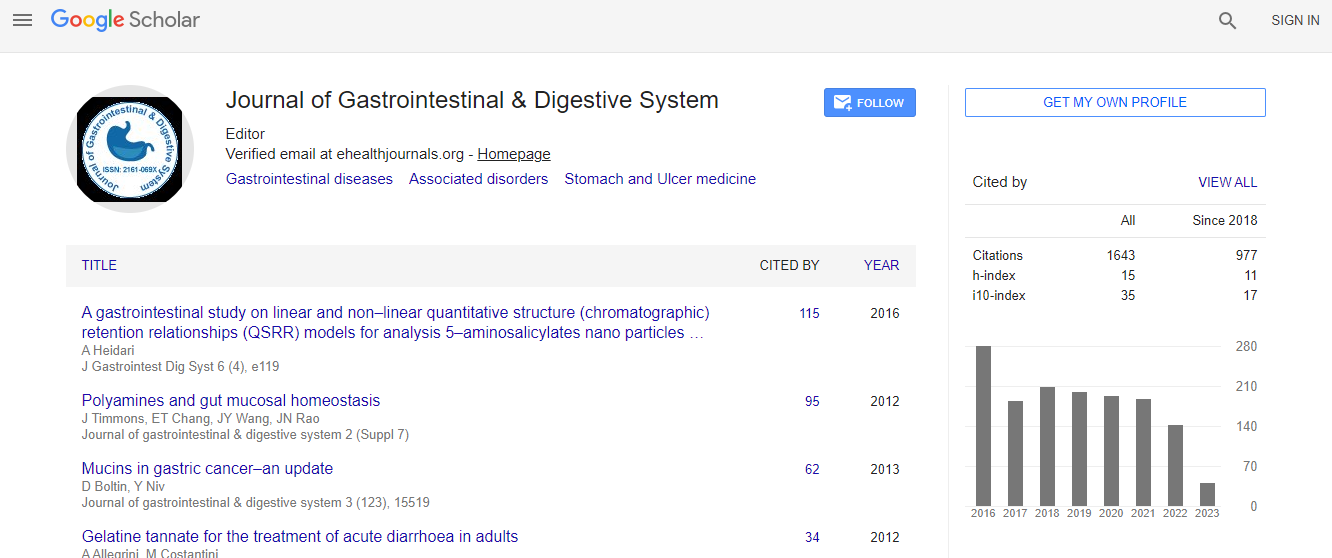Our Group organises 3000+ Global Conferenceseries Events every year across USA, Europe & Asia with support from 1000 more scientific Societies and Publishes 700+ Open Access Journals which contains over 50000 eminent personalities, reputed scientists as editorial board members.
Open Access Journals gaining more Readers and Citations
700 Journals and 15,000,000 Readers Each Journal is getting 25,000+ Readers
Google Scholar citation report
Citations : 2091
Journal of Gastrointestinal & Digestive System received 2091 citations as per Google Scholar report
Journal of Gastrointestinal & Digestive System peer review process verified at publons
Indexed In
- Index Copernicus
- Google Scholar
- Sherpa Romeo
- Open J Gate
- Genamics JournalSeek
- China National Knowledge Infrastructure (CNKI)
- Electronic Journals Library
- RefSeek
- Hamdard University
- EBSCO A-Z
- OCLC- WorldCat
- SWB online catalog
- Virtual Library of Biology (vifabio)
- Publons
- Geneva Foundation for Medical Education and Research
- Euro Pub
- ICMJE
Useful Links
Recommended Journals
Related Subjects
Share This Page
Ammonia level may not be associated with the severity of hepatic encephalopathy: An extensive literature review
14th Annual Congress on Gastroenterology & Hepatology
Eyad M O E Gadour
University Hospital of South Manchester NHS Foundation Trust, UK
ScientificTracks Abstracts: J Gastrointest Dig Syst
Abstract
This literature provides a review regarding the value of checking ammonia level in hepatic Encephalopathy. The research examines the prognosis of Ammonia level in the blood, diagnosis and management of hepatic encephalopathy. The major clinical characteristics of diagnosis of hepatic encephalopathy are depressed consciousness level, intellectual impairment and personality changes. During diagnosis, it is essential to detect signs suggesting hepatic encephalopathy among the patients suffering from liver disease and there is no clear indication of other causes to brain dysfunction. Thus, realization of precipitating factors indicated above supports hepatic encephalopathy diagnosis. The prognosis depends on the grade of liver failure, time of delivering effective treatment particularly precipitating factors and comorbidity. The progress of hepatic encephalopathy among patients with cirrhosis is correlated with a worse prediction and might cause frequent and elevated relapses. The patients with obvious hepatic encephalopathy in the hospitals have a 3.9 risk of increased mortality. Approximately 70% of having cirrhosis exhibit restrained symptoms of hepatic encephalopathy. These symptoms are likely to weaken patients. Obvious hepatic encephalopathy manifests in patients suffering from cirrhosis, and the approximate infection rate is 30 to 45%. About 25 to 53% port systemic shunt surgery patients exhibit the condition. The suitable management practices entail early diagnoses, aggressive identification of the precipitating factors and efforts to reduce severity. Evasion of some sedative drugs has been proposed as a key management practice. The main approaches suggested in include: (1) Checking the level of arterial ammonia during first evaluations in patients hospitalized due to impaired mental function and or cirrhosis. In stable outpatients, ammonia levels are low. (2) Correcting hepatic encephalopathy precipitants including constipation, gastrointestinal bleeding, metabolic disturbances and hypovolemia. (3) Providing prophylactic endotracheal intubation to patients with grade 3 or grade 4 (severe encephalopathy) and have aspiration risks in the Intensive Care Unit (ICU). Lactulose and Rifaximin use is useful but no superiority and can both be used if needed. Administration of low-protein diets in cirrhosis patients resulted in deteriorating of established protein-energy malnutrition. Thus, protein restriction is likely to help some patients with immediate effect after episodic hepatic encephalopathy. Certainly, malnutrition is regarded as a serious clinical problem compared to hepatic encephalopathy among the patients. Blood ammonia mainly comes about due to the breakdown of the unabsorbed dietary protein by bacteria in the intestines. Among the hepatic encephalopathy, the levels of ammonia in the brain are higher compared to blood levels. High levels of ammonia in the blood may occur because of gastrointestinal bleeding, acute liver failure and chronic liver disease. The major reasons for testing ammonia levels in hepatic encephalopathy for patient who is presenting for the first time include: Checking for success of treatment options, checking for liver condition following severe symptoms like excessive sleepiness and confusion, identifying disorders likely to cause brain damage, help in predicting outcomes from diagnoses carried out prognosis of hepatic encephalopathy, however, for patients who are known to have hepatic encephalopathy, in terms of recurrent admissions or previous diagnosis, checking ammonia is not routinely recommended and carrying out the psychometric tests may be more useful.Biography
Eyad M O E Gadour has an MRCP in Gastroenterology Spr from University Hospital of South Manchester NHS Foundation Trust in UK. He is currently working in University Hospital of South Manchester NHS Foundation Trust, UK.
E-mail: eyadgadour@doctors.org.uk

 Spanish
Spanish  Chinese
Chinese  Russian
Russian  German
German  French
French  Japanese
Japanese  Portuguese
Portuguese  Hindi
Hindi 
